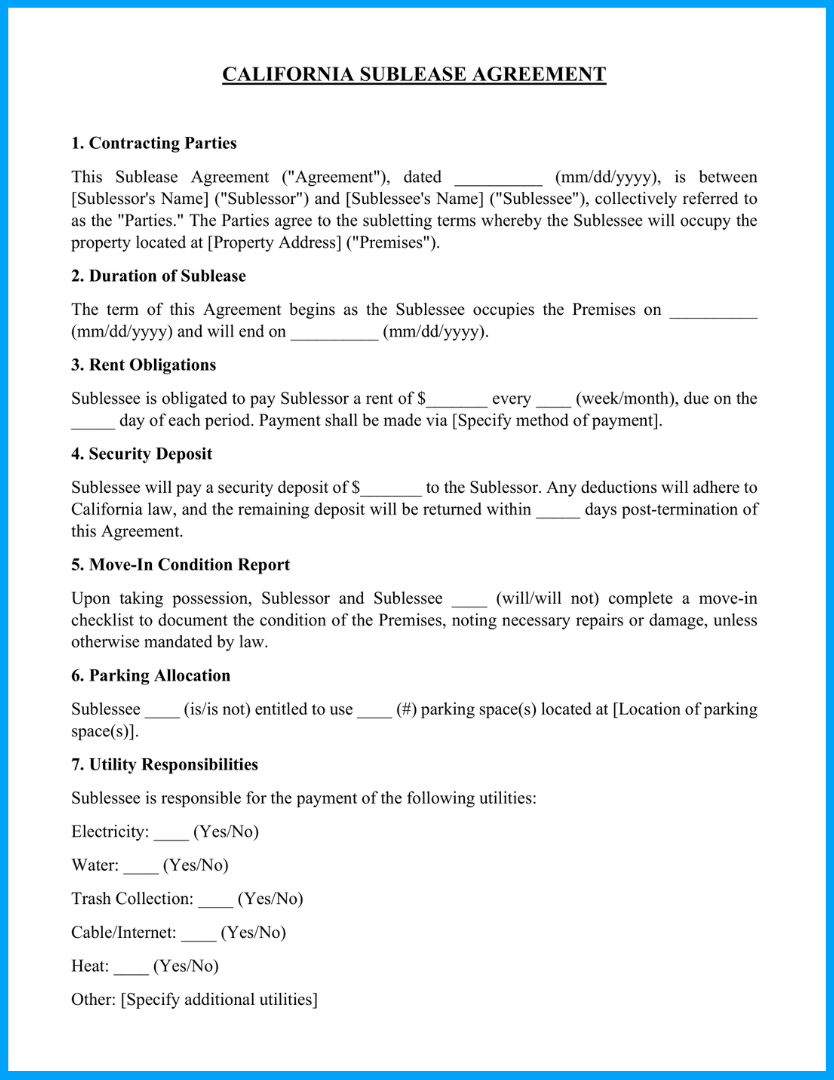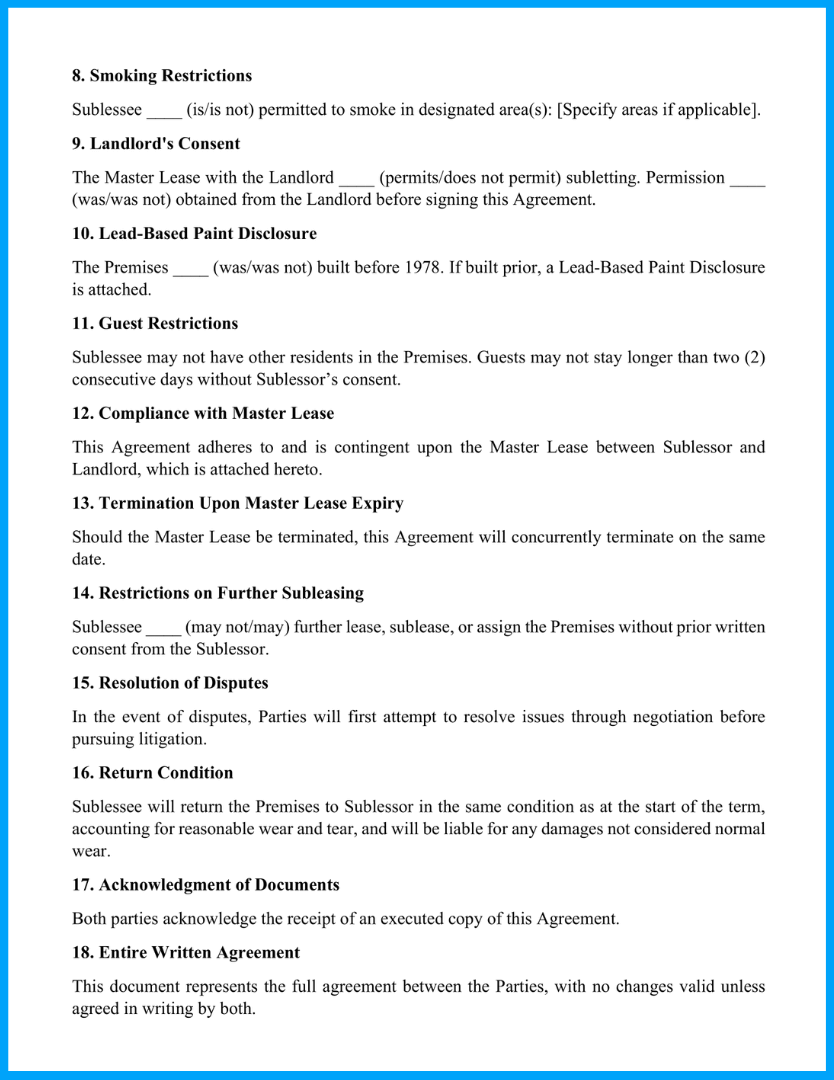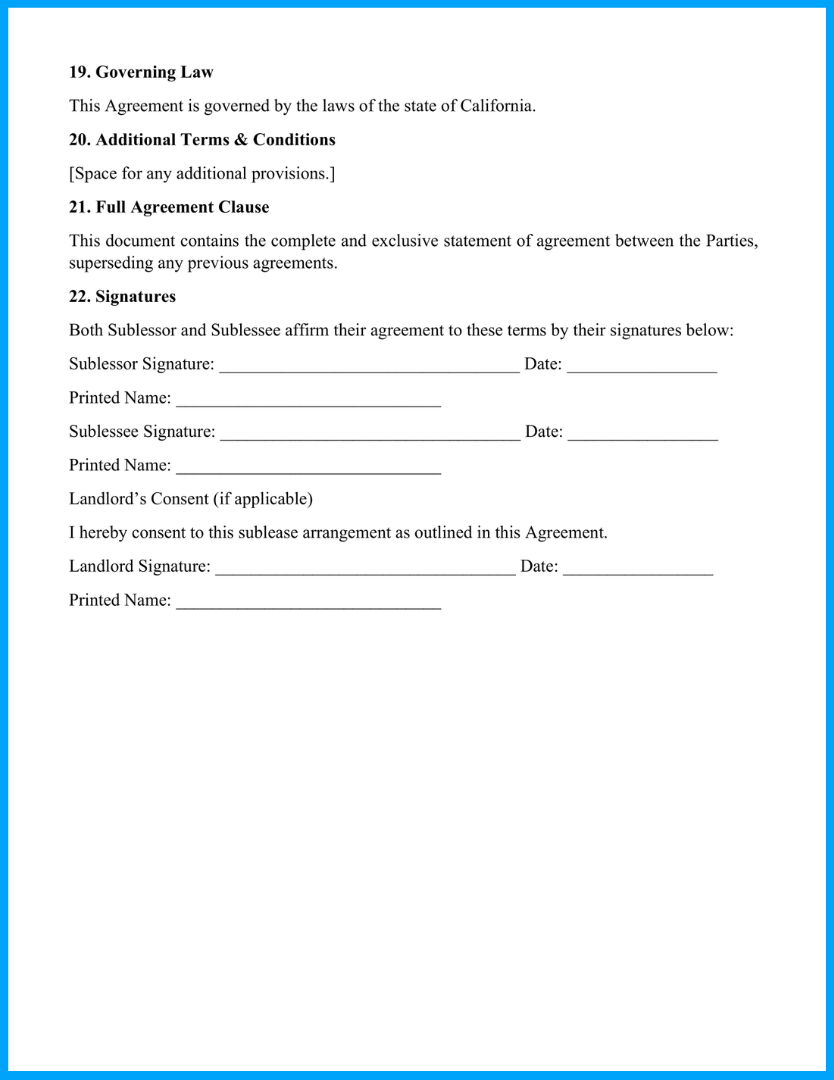Sublease Agreement California: Key Information + Free Template
This guide examines crucial legal facets of California subleasing—from properly securing landlord electronic signatures and permission to navigating transient occupancy taxes—and supplies a downloadable Golden State template outlining essential occupant transfer terms.



Right to Sublet: Is Subletting in California Legal?
When it comes to subletting in California, tenants do have the right to sublease, but there are some restrictions tenants need to be aware of. Subletting is not an automatic privilege extended to renters. Instead, tenants must obtain explicit written consent in a California sublease agreement from their landlord before subletting to a new tenant.
The key elements for properly requesting permission to sublet in California include:
- Carefully reviewing the existing rental agreement template for any clauses related to subletting. If subletting is expressly prohibited, the tenant can try to negotiate an amendment with the landlord.
- If subletting is allowed or the lease does not mention it, the tenant can proceed with a formal written request to the landlord. This request should detail information about the proposed subtenant, including income, credit score, references, etc., and clearly outline the sublease terms like duration and rent amount.
- Tenants should allow 1-2 weeks for landlord response time. If 30 days pass with no response, the tenant can send a reminder about the landlord’s duty to mitigate damages by allowing reasonable sublet requests in the California sublease agreement.
- Finally, obtain the landlord’s signed, written approval before proceeding with finalizing the sublease agreement template.
Landlords do have rights like denying unqualified tenants but cannot prohibit subletting altogether without valid, reasonable objections. The original lease-holding tenant also maintains all responsibilities, like ensuring subtenant lease compliance and paying rent to the landlord.
When to Use a Sublease Agreement in California
There are many situations where a California sublease can provide flexibility for tenants. If you need to temporarily relocate but want to retain control over your existing lease, subletting allows you to legally occupy the property again in the future while covering costs in the interim.
Other common reasons are financial hardship, studying abroad, job relocation, or testing compatibility with a possible new roommate. The benefits of crafting a sublease vs. breaking a lease include maintaining a good relationship with your landlord, avoiding lease violation fees, preserving the option to return to the property, gaining income from unused space, and clearly delineating responsibilities between tenants. A sublease also provides legal protection for all involved parties.
Key Components of a Sublease Agreement California
A well-crafted room rental agreement template is essential to protect the interests of both landlord and tenants. California law does not provide a standard sublease contract, so the parties involved must include key provisions to minimize disputes. While specific terms differ case-by-case, most California subleases should contain:
Sublessor and Sublessee Details
Full legal names, current addresses, contact details (phone, email), and identification numbers (driver’s license or social security numbers) of the sublessor (original tenant) and sublessee (new tenant) when sending documents for electronic signature. This establishes the legal identities involved, enables communication about the sublease, and aids legal proceedings if necessary. Thorough background checks are also facilitated if the landlord requires them.
Description of the Rental Premises
The sublease agreement template should feature a complete description of the property’s location and boundaries. This includes the full address, inventory of furnished items or appliances (if applicable), existing damage documentation, and —most critically— clear delineation of spaces being sublet (e.g., bedroom, shared living room, etc.). Explicitly defining these details prevents major misunderstandings about access, property conditions, property management, and sublessee rights.
Duration of the Sublease Arrangement
Concrete start and end dates for the sublease period must align with the original master lease to avoid conflicts. Outlining extension policies or early termination clauses also provides structure if the sublessee needs to renew or depart early. Notice periods for moving out (typically 30 days) should be set. Clearly defined sublease duration manages expectations, allows the sublessor to plan their return or find a replacement, and prevents lease term violations.
Rent Payment Amount and Due Dates
Payment amount, due date, and late fee policies likely differ from the original lease. The sublease should establish new rental rates, pro-rated if only renting certain rooms, and due dates between the 1st and 5th of each month. Outline penalties for late payments and the protocol for repeatedly handling late rent. Does interest accrue? Will the sublease terminate after multiple violations? Transparent financial terms prevent payment disputes down the road.
The sublease must establish:
- The monthly rental rate and exact due date between the 1st and 5th of each month.
- Acceptable payment methods, typically online, check, or money order.
- Late fee amounts after 5, 10, or 15 days past due.
- An itemized breakdown of any utilities, parking, storage, or other regular costs the sublessee must pay either to the sublessor or directly to third parties.
- The upfront security deposit amount is based on 1-3 months’ rent. Outline clear stipulations for deductions and return time frame when the sublease ends.
Defining these details prevents financial disputes about rent rates, responsibility for recurring costs, or consequences of late/non-payment later on.
Security Deposit
Key provisions regarding the security deposit should cover:
- The amount required upon move-in is typically equivalent to 1-3 months of rent.
- The purpose is to provide financial protection for the sublessor, covering damages or unpaid rent.
- Return policy mandating deposit refund or deductions itemization within 21 days when the sublessee vacates the unit. This aligns with California law.
- Clear security deposit terms prevent disagreements when the arrangement ends.
Utilities & Other Recurring Bills
Specify exactly which utilities or services the sublessee must secure and pay for directly versus charges included in rent. This includes payment logistics – whether the sublessee pays the third-party provider directly or reimburses the sublessor a portion of existing bills. Timeframes align with billing cycles and due dates to maintain seamless payments.
Authorized Occupants
Name any authorized occupants permitted to live in the unit beyond the primary sublessee. Typically includes spouse, partner, children, immediate family.
This may require background checks on additional occupants before granting permission. Restrictions on the number of guests allowed at one time or total stay duration prevent unauthorized tenants the sublessor hasn’t approved or safety/overcrowding issues violating original lease terms.
Alignment with Master Lease
Specify that the one page lease agreement must comply with all terms in the master lease between a property owner and the original tenant. If the master lease prohibits subletting, new written consent from the landlord must be obtained first. Sublessee agrees to avoid jeopardizing the main tenant’s standing per the original lease.
It is crucial for validating the sublease arrangement meets requirements and that the renter maintains compliance.
Extra Provisions
Based on specific building, neighborhood, or city ordinances, include clauses addressing:
- Pet permissions or restrictions
- Smoking and vaping policies
- Guest visitation rules
- Parking space allotments
- Noise level restrictions
- Waste disposal procedures
- Eviction notice procedures
Liability & Dispute Resolution
The yearly or month to month agreement template should clearly state the responsibilities and liability of both the sublessor and sublessee regarding property damage, injuries, or other issues that may arise. Required insurance policies and any applicable indemnification clauses protecting the sublessor can also be included. To address potential conflicts, provide a framework for dispute resolution, such as timelines and procedures for mediation, arbitration, or filing formal legal proceedings if unresolved disputes persist between the parties. Defining accountability upfront and plans for handling disputes reduces major problems down the road.
Signatures
The sublease legal document requires the full legal names, dates, and original signatures of both the sublessor (original tenant) and sublessee (new tenant). All pages should be initialed. If the master lease stipulates, include space for the landlord to sign and approve the sublease.
Attaching any separate written consent forms from the landlord is essential as well. For convenience, options for online signing like Signaturely align with California electronic signature laws to enable secure and legal remote execution. Complete verified signatures legally validate the sublease agreement, provide evidence of the landlord’s permission, and confirm all parties consent to the defined terms and conditions.
Considerations for California Sublets
When arranging a sublease agreement in California, tenants must comply with several state-specific laws and best practices to ensure a smooth process. Legally, written consent from the landlord is mandatory before subletting per California state statutes. The original lease agreement’s subletting policy must be followed. If prohibited, negotiate an amendment with the landlord first. Tenants looking to sublease units built before 1978 must also provide subletters with a federally mandated Lead-Based Paint Disclosure outlining potential health hazards.
Local regulations, such as rent control ordinances in San Francisco and Los Angeles, additionally impact legal rental rates and subletting policies. Transient occupancy taxes for sublease agreements less than 30 days may apply, depending on the city and county. Subtenants have clearly defined rights under state law, including the expectation of a habitable rental and formal procedures for security deposit returns when vacating. Landlords must make reasonable efforts to mitigate damages if tenants break leases early, such as accepting qualified replacement subletters.
On the practical side, thoroughly screening subtenants with background/credit checks and maintaining clear documentation is key. Using a comprehensive sublease agreement that aligns with California laws is essential, potentially leveraging PDF digital signing and electronic signature platforms like Signaturely for convenience and legitimacy.
Tax Implications for Subleasing in California
The main tax implication for California sublessors involves transient occupancy tax (TOT). This applies to subleases lasting less than 30 consecutive days. TOT rates range from 8% to 15.5%, depending on the specific city and county.
Registration is required with local tax authorities before collecting TOT from subtenants. Even if no income was collected, regular tax returns must be filed to avoid penalties like fines or legal action.
At the state income tax level, rental proceeds earned from subletting may count as taxable income, depending on individual circumstances. Consultation with a tax professional is advisable to understand reporting requirements. On the local level beyond TOT, some cities implement other specialized taxes that sublessors must consider when establishing sublease financial terms.
Thorough research on local regulations is essential to avoid failing to collect and remit mandatory taxes from subtenants. The original leaseholding tenant is ultimately responsible for tax compliance, not the sublessee.
Download our free example
Sublease Agreements in California
We’ve got your back here at Signaturely, and we’re ready to help make stress-free contracts a reality. Forget the confusing paperwork and overwhelming legal jargon – get easy, breezy contract templates in minutes with our free template.
What You Need to Remember About Sublease Agreements in California
Legitimately occupying another’s California rental hinges on strict permissions precedent, tactical tax protocols navigation, transparent written conferment of customized considerations between engaged parties, and pragmatic tenant screening. Signaturely’s turnkey template facilitates fast sublease creation.
FAQs About Sublease Agreement California
Below are a few of the most frequently asked questions and answers about sublease contracts in California.
Is subleasing legal in California?
Subleasing is generally legal in California but does require explicit written consent from the landlord first. If the original lease agreement prohibits subletting, the tenant must negotiate an amendment with the landlord before proceeding.
How to write a sublease agreement for California?
When constructing a California sublease contract, use a state-specific template and include all essential components like tenant identities, property details, duration, rent rates, etc. Attaching the original master lease and obtaining in-person or electronic signatures are critical for validating compliance.
What is the difference between sublet and sublease?
The terms “sublease” and “sublet” are often used interchangeably, but a sublease tends to involve taking over the full rental property for a longer duration, whereas a subtenant may rent a room or partial space short-term. Both arrangements involve an original tenant renting to a new tenant.
What is a landlord’s consent to sublease letter?
Before subletting in California, current tenants must obtain a formal letter from their landlord authorizing the sublease and specifying any restrictions. This consent letter legally authorizes the subletting under state law and provides protection in the event of lease violations. Without the landlord’s express permission, leases may be considered void.
Free Sublease Agreement California Template
CALIFORNIA SUBLEASE AGREEMENT
- Contracting Parties
This Sublease Agreement (“Agreement”), dated __________ (mm/dd/yyyy), is between [Sublessor’s Name] (“Sublessor”) and [Sublessee’s Name] (“Sublessee”), collectively referred to as the “Parties.” The Parties agree to the subletting terms whereby the Sublessee will occupy the property located at [Property Address] (“Premises”).
- Duration of Sublease
The term of this Agreement begins as the Sublessee occupies the Premises on __________ (mm/dd/yyyy) and will end on __________ (mm/dd/yyyy).
- Rent Obligations
Sublessee is obligated to pay Sublessor a rent of $_______ every ____ (week/month), due on the _____ day of each period. Payment shall be made via [Specify method of payment].
- Security Deposit
Sublessee will pay a security deposit of $_______ to the Sublessor. Any deductions will adhere to California law, and the remaining deposit will be returned within _____ days post-termination of this Agreement.
- Move-In Condition Report
Upon taking possession, Sublessor and Sublessee ____ (will/will not) complete a move-in checklist to document the condition of the Premises, noting necessary repairs or damage, unless otherwise mandated by law.
- Parking Allocation
Sublessee ____ (is/is not) entitled to use ____ (#) parking space(s) located at [Location of parking space(s)].
- Utility Responsibilities
Sublessee is responsible for the payment of the following utilities:
Electricity: ____ (Yes/No)
Water: ____ (Yes/No)
Trash Collection: ____ (Yes/No)
Cable/Internet: ____ (Yes/No)
Heat: ____ (Yes/No)
Other: [Specify additional utilities]
- Smoking Restrictions
Sublessee ____ (is/is not) permitted to smoke in designated area(s): [Specify areas if applicable].
- Landlord’s Consent
The Master Lease with the Landlord ____ (permits/does not permit) subletting. Permission ____ (was/was not) obtained from the Landlord before signing this Agreement.
- Lead-Based Paint Disclosure
The Premises ____ (was/was not) built before 1978. If built prior, a Lead-Based Paint Disclosure is attached.
- Guest Restrictions
Sublessee may not have other residents in the Premises. Guests may not stay longer than two (2) consecutive days without Sublessor’s consent.
- Compliance with Master Lease
This Agreement adheres to and is contingent upon the Master Lease between Sublessor and Landlord, which is attached hereto.
- Termination Upon Master Lease Expiry
Should the Master Lease be terminated, this Agreement will concurrently terminate on the same date.
- Restrictions on Further Subleasing
Sublessee ____ (may not/may) further lease, sublease, or assign the Premises without prior written consent from the Sublessor.
- Resolution of Disputes
In the event of disputes, Parties will first attempt to resolve issues through negotiation before pursuing litigation.
- Return Condition
Sublessee will return the Premises to Sublessor in the same condition as at the start of the term, accounting for reasonable wear and tear, and will be liable for any damages not considered normal wear.
- Acknowledgment of Documents
Both parties acknowledge the receipt of an executed copy of this Agreement.
- Entire Written Agreement
This document represents the full agreement between the Parties, with no changes valid unless agreed in writing by both.
- Governing Law
This Agreement is governed by the laws of the state of California.
- Additional Terms & Conditions
[Space for any additional provisions.]
- Full Agreement Clause
This document contains the complete and exclusive statement of agreement between the Parties, superseding any previous agreements.
- Signatures
Both Sublessor and Sublessee affirm their agreement to these terms by their signatures below:
Sublessor Signature: __________________________________
Date: _________________
Printed Name: ______________________________
Sublessee Signature: __________________________________
Date: _________________
Printed Name: ______________________________
Landlord’s Consent (if applicable)
I hereby consent to this sublease arrangement as outlined in this Agreement.
Landlord Signature: __________________________________
Date: _________________
Printed Name: ______________________________
Download Our Free Sublease Agreement California Template Today
Don’t waste any more time trying to craft the perfect sublease agreement california template. Our simple sublease agreement california template is ready and ready to download in one quick, convenient click—no more complicated documents for you or your clients to fill out.
Just download, customize, and off you go!